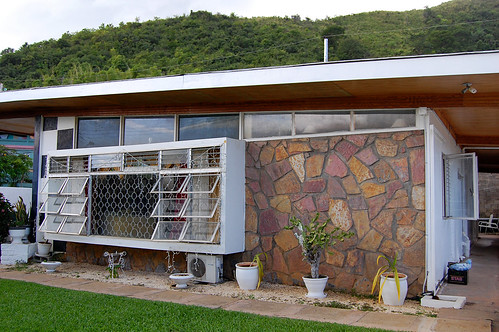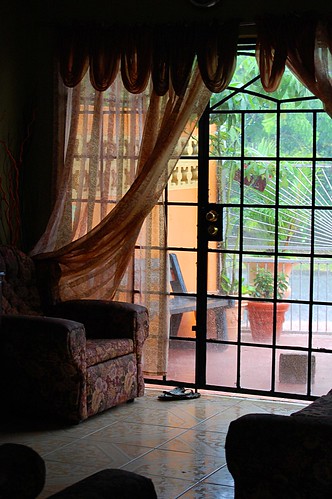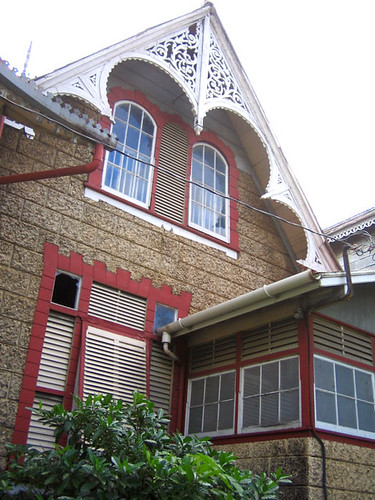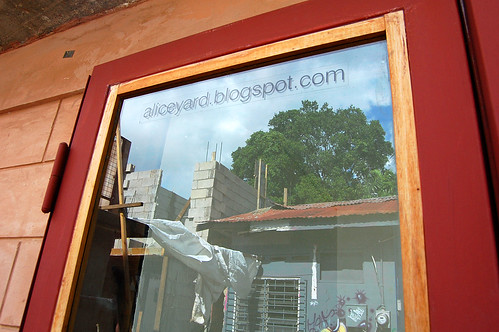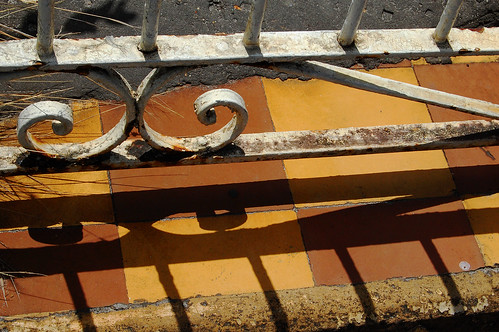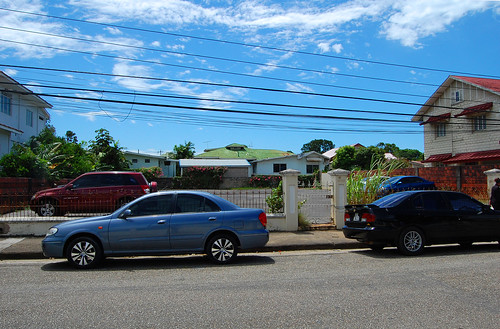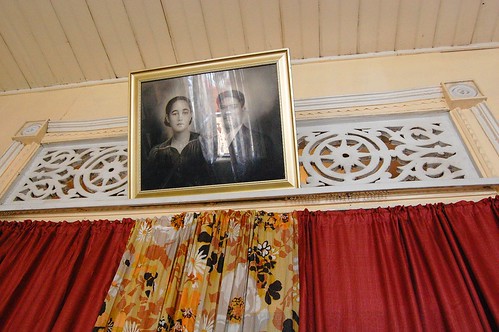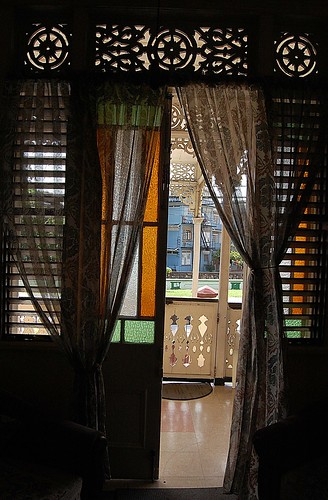I’ve spent the past four months living and studying in Trinidad and Tobago, pressed with the challenge of photographing and documenting aspects of the culture. On a straightforward level, I assigned myself the topic of exploring the performance of religion in Trinidad, as well as the performance of mas during Carnival season. Along the way, I’ve experienced culture shock while trying to negotiate the temporal and special cultural differences embedded in the flow of everyday life. The issues that face any photographer were a regular struggle: developing an eye, communicating with the subject, arranging composition and form. Yet because I was an American student transplanted into a different country, I had to be aware of the history of colonialism and ‘orientalism’ that shaped the foundation of Trinidad, and how European/American photographic history in the Caribbean has reflected a colonizer/colonized narrative, as the European eye visually controlled its subjects, recasting the landscape to fit a mold of economic exploitation and tourism which highlighted the ‘native’ and the exotic. Keeping this in mind, Trinidad has confronted me with my own identity within a new space. I am a young, white American female with privilege and access to institutionalized education. I am leaving mainstream ‘normative’ American culture to foray into a Caribbean locale of religious and performative tradition, all of which have been shaped in relation with the colonizer discourse. I have to be mindful of the idea of a camera as a weapon for controlling, recasting, and stating truths that may exist only in my mind. But at the same time the camera can be merely an open, absorbing receptacle to an existing landscape – allowing the camera to function as an unconscious extension of my cultural encounters, of my personal background and my emotions, and my individual eye and visual perceptions. My photographs have concentrated primarily on the theme of performance. Carnival is all about playing mas, becoming a character, and through that character or alternate persona, really being you in a liberated, transcendental state. I find that sort of emancipation through performance is similar within religious tradition as well. Trinidad and Tobago is saturated with religious imagery and rituals, from Hindu pujas to Catholic burials to Shouter Baptist celebrations. The rituals are performative in nature – religion is a communal event, connecting people to each other and to the idea of another spiritual dimension. And as a photographer, I find the matrix of colors and forms to be revealing, a creation of a visual language to explain the unconscious. I don’t pretend to be an expert at any of this. My entire experience here has been very amateur: only skimming the surface of what it means to be Trinidadian. But this encounter has provided me with a re-evaluation of myself and how I can connect to this liberation narrative, finding out how much of me is about being American, and how much of me truly belongs to a wider community.

Catholics gather in the early hours of Good Friday to watch the re-enactment of Jesus Christ’s trial and crucifixion through the Stations of the Cross at Mount Saint Benedict Monastery in Tunapuna, Trinidad.
Probably the first striking thing about Trinidad and Tobago is the way space is conceptualized and utilized differently than in America. Architecture comes in a variety of forms: modern, Western cityscapes exist side-by-side with empty lots, homes put together from spare materials, marketplaces erected in the shadow of a KFC. The space seems entirely human made, rather than sterile and mass-produced. Even the writings of a menu on the wall, or the business hours of a store, are hand painted. People move seamlessly through these industrial and rural spaces, as they always seem joined together. Trinidadian time moves differently as well, not necessarily in the linear, frantic pace I’m accustomed to in New York. Things happen when they happen, and moving somewhere can be as much as part of the experience as actually arriving or accomplishing the goal. The way people occupy space has caught my attention. It has taught me to see Trinidad in terms of spatial movement: how the landscape reflects layers of experiences. Empty space is as significant as ‘meaningful’ space.

A gravedigger dances while assisting in the burial of Parang singer Tito Lara at the Santa Cruz R.C. Church, as family members look on.
One of my first true “cultural shocks” in Trinidad was when I attended the Catholic funeral of Tito Lara, a Parang singer in Santa Cruz. His funeral was highly publicized, as he was a well-known and beloved member of the community, and in attendance were family, friends, and Trinidadians from all over the country that came to pay respects. I was caught off guard upon entering the Church grounds: the space was occupied by numerous people, sitting, standing, liming among the graves, which were organized rather haphazardly; they were dug in a seemingly random manner, often blending into the environment as they were covered with dirt, grass and leaves. This contrasted significantly with my American funeral and graveyard experiences, which are always very pristine, sterile, and tightly organized. The Catholic funerals I’ve attended at home made a point, it seemed, to distance the event from what it really means to be dead and buried. Family members left the graveyard before the burial of the coffin, whereas at this funeral, the coffin was lowered into the ground as the crowd looked on, crying, singing, and tossing dirt from the earth onto the coffin. It was practically a transcendental experience for me, as I was thrust into the crowd, and ordered to take pictures by people standing around the grave. I was nervous with adrenaline and unfamiliarity: I was standing practically barefoot in the very dirt that was picked up to toss onto the coffin and sealed into the ground. It was difficult to locate myself in this chaos of noise and movement, and I sort of let the camera take over and connect with my instincts, using it as a barrier between the experience and myself. I would absorb and process the event much later, but in the moment, the camera functioned as a cultural translator for me, recording a time for my consideration later, when I was at a safe distance. This reflects a tension that I had while photographing almost all events in Trinidad. I had only academic, second hand knowledge of what would be occurring at the event, and while I was inside the moment, I had to balance between becoming overwhelmed by the new experience and taking a detached, documentary viewpoint. I tried to let the camera speak for me, to pick up what was happening and perhaps the photographs would bear testament to my own confusion and misunderstandings.

A girl works a marketplace both in the streets of Siparia during La Divina Pastora, a religious festival held on Holy Thursday. The statue of La Divina Pastora, kept by the local Catholic Church, is shrouded in myth and is said to have miraculous powers. Every year, Hindus migrate to the site to pray and give offerings to the statue and the poor, as an Indian bazaar is held in the streets around the Church to accommodate visitors.
Perhaps one of the most obvious experiences I encountered while photographing in Trinidad is the danger of reducing subjects, who are, to me, “foreign”, as “others”, especially in the historical and social context of colonialism and racial exploitation. As a white American, I had to be aware of the role I might play and assumptions I might make: that Trinidadian culture is foreign, not “modern”. That I might frame what I see only in terms of differences from my American experience. The cultural encounters had me as an outsider trying to find meaning in a visual experience, and I was afraid to disrespect the event by focusing on the wrong aspect, framing the event as something it was not, or something I mistakenly assumed it to be. I was often uncomfortable to approach strangers with my camera, using it to capture them for my own edification. During La Divina Pastora, many people swarmed in the streets of the bazaar, selling and buying, interacting with intensity. I took this opportunity of movement and confusion to prepare myself mentally with determination that I would take portraits, no matter what, and without really showing ‘mercy’ to people. I wouldn’t be shy, I wouldn’t ask permission, I would just use the camera to surreptitiously get a sense of how people looked during a transaction. One of my favorite portraits is when I aimed my camera at a young girl looking rather bored as her mother completed such a transaction. She was staring away when I raised the camera, but as I clicked, she turned towards me. She has a rather intense look on her face. I felt that my determination to get shots of people was matched in her gaze: we were both staring each other down. This was a moment when I was able to get more comfortable using a camera in Trinidad.

Children in mas pass by an old building during Children’s Carnival in downtown Port-of-Spain.
Something I liked to experiment with was the idea of seeing beyond what was objectively the surface of an image. For instance, catching the backs of children’s mas during their carnival, the way the free-flow of their white costume was a stark contrast to the old, weathered building in the streets of Port-of-Spain. Art against an institution of function. One of my failings is that I am not very skilled at interpreting meaning in the moments of photographing. I tend to find interesting quirks and forms afterward. Sometimes I can sense when there is an interesting contrast happening, but I am not able to fully process it until later. Finding shapes, colors and lines within a mundane setting is one of the aesthetic things that I enjoy about photography. I am interested in using different perspectives, forcing myself physically to move my body to lower or higher levels, to see something in a new way.

Players in Carnival Tuesday pass by a homeless man in downtown Port-of-Spain
The image of the Caribbean as exported to the rest of the world is one of sun, sea, and sand. A vacation, a paradise. Yet this imaging is constructed by those who wield power and influence, who are exerting their control over place to market it to other Americans/Europeans. Trinidad is outside the predominant tourist industry, but it is still presented as a place to lime, a “get away” from the “real” world, a place of music and fun. The realities and context of the Caribbean need to be considered when photographing. It should not be objectified as either a tourist paradise, nor should the poverty and distress be a central focus either, which renders the Caribbean as destitute, in need of help that only “first world” countries can offer. Trinidad is much deeper than that.

Shouter Baptists celebrate the annual holiday of Shouter Baptist Liberation Day, which commemorates the repeal of the 1951 Shouter Prohibition Ordinance, which forbid Shouter Baptists from gathering to practice their religion.
Trinidad is a land of struggle and emancipation. The country’s history is riddled with suppression of freedoms and creative self-expression, and tension among different ethnic and religious groups. The Shouter Baptists were prevented from practicing their religion by the government, for example. When photographing, it’s helpful to be aware of the nation’s history, to pick up on the significance of certain events, such as the marginalization of certain peoples, and what the social norms are in terms of religious identity. Shouter Baptists tend to be on the margins of society, as they fuse Christianity with African traditional religious practices, which can be seen as threatening.

A vendor sells framed images of Jesus along with various Hindu devas and devis during La Divina Pastora in Siparia. The event brings together Hindus and Catholics, as Catholics worship during Holy Thursday mass, and Hindus pray and give offerings to the statue.
Trinidad is a multi-cultural society featuring the encounter between Africans, Indians, Chinese, Europeans, all sharing different languages, religions, and traditions. There are many divisive lines between these cultures, yet what is more interesting is the ways that they interconnect and affect each other. The European colonial influence is obvious, but the ways that tradition remains provoke attention. The celebration of La Divina Pastora on Holy Thursday brings together Catholics and Hindus, and the bazaar outside the church reflects this, as vendors cater to both Hindu and Catholic iconography. There might be a distinct cultural separation between Christians and Hindus in the country, but everyone is Trinidadian, and the ways that they come together are examples of fusion and exchange.

A mausoleum in Lapeyrouse Cemetery in Port-of-Spain is juxtaposed against the PowerGen energy plant, which provides electrical power to Trinidad and Tobago.
Religion plays an omnipresent role in Trinidadian society. Religious imagery is everywhere. Bumper stickers and the name of God are invoked on cars and public transportation, churches and temples are found on nearly every block. The distinction between the secular and the spiritual is blurred when walking through the streets of the country, everywhere are symbols indicating the existence of religious life: jahndis, Christian t-shirts, pictures of devas and devis, rosaries. The role that religion plays in Trinidadian life appears to be so normalized that there is little transition between religious practice and symbolism, and secular, daily routine.

Actors dress as biblical figures in the crucifixion of Jesus on Good Friday, during a re-enactment of the Catholic Stations of the Cross at Mount Saint Benedict in Tunapuna, Trinidad.
Almost immediately upon arrival in Trinidad, we were told that Trinidadian culture itself could be viewed as a kind of mas. Performance is central to all human beings – we all perform outward personalities, we role-play when interacting with other people. But in Trinidad, the act of expression through symbolic meaning seems to carry more resonance. The religious undercurrent in Trinidad seems to be an extension of this: involving yourself in a larger, transcendental community, playing a role within this community, outwardly projecting something intrinsically spiritual and indefinable, making the spirit visible. Performing religious rituals connects people to their environment and makes a space for the self in the world. It’s using creativity to make visual meaning out of physical objects. The Stations of the Cross, re-enacted on Good Friday by Catholics, is a literal example of performing religion. It’s a mas, ritualizing the death of Jesus. The photographs I took of the Stations of the Cross are some of my favorite, because the experience felt surreal: people dressed as biblical figures, playing ‘God’ and his followers. The images I took were blurred not just because of the dim lighting and movement, but because the moments, or ‘stations’, of action, felt static like a painting, or something dreamlike. The Stations of the Cross helped validate the meaning of performance-in-religion in a real way for me, because it involved a moving truck with loudspeakers announcing the narrative of each station, and the men who were ‘whipping’ Jesus carried and cracked their whips identical to the Carnival Jab-Jabs. All along the journey to the final station, Catholics trailed behind, stopping at each station to take a moment of pause. It was eerily reminiscent of J’Ouvert dawn, or Carnival Tuesday – a group of people walking a set path, a moving truck with bellowing music and announcements, and periods of rest, functioning like the ‘judging points’ of Carnival. Except instead of jumping and wining, people were solemn, carrying candles instead of cups filled with alcohol. The connections between performing mas and performing religion were quite apparent to me during this religious re-enactment.

A young girl dances in the rain during Children’s Carnival in Port-of-Spain
Photographing Trinidad has been a challenge for me, in confronting my own identity and how I am received and perceived in a new culture. It’s been about encountering different conceptions of time and space, using the camera as both a mechanism of capturing others and shielding me from a direct encounter with culture shock. Recognizing Trinidad’s history, context and routine imagery has been part of the experience in rendering moments. Overall I’ve identified a theme of performance – performing mas, performing religion. These both serve as tools of emancipation to transcend the self. Within a defined social space, moments of liberation and transcendence can occur even within a ritualized and pre-conceived performance. Perhaps it is these well-known guidelines and repetitive structures of ritualized performance that help bring us together and beyond the mundane. Photographing Trinidad has been about constant negotiation: between my culture and this culture, feeling out the tensions within this culture, finding connections, balancing a comfort level between subject and photographer, and understanding the relationship between ritual performance and spontaneous performance. The theme of liberation through performance is central to what I’ve understood about Trinidad: that transcending the ordinary is part of the human condition. It manifests itself in both secular and religious outlets, and sometimes the two are indistinguishable.
